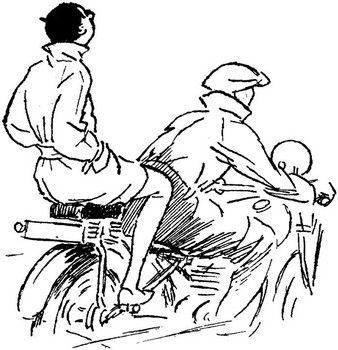
Feel the wind rushing across your face, your hair blowing into the depths of your helmet. Taste the tiny bugs as they whiz into your too-open mouth. Riding on the back of a motorcycle is exhilarating, but without the proper know-how you may feel like you're holding on for your life. Such an out-of-control feeling is both frightening and uncomfortable. Learn to have a safe and savvy backseat excursion.
Wear the appropriate riding gear. This includes long sleeves, closed-toed shoes and a helmet.
Mount the bike. But, beware, the driver must be on the bike and ready for your mount. Stand near the back of the bike. Lift your leg over the rear of the seat until your foot reaches the peg on the opposite side of the bike. Once foot is touching the peg, your bum should be in contact with the seat. Lift your other foot from the ground and place it on the other, still unoccupied, peg. Settle yourself on the seat until you feel balanced and secure.
Find a place to hang on. You have two choices. I prefer to hold on to the driver; this requires you to situate your hands under the driver's arms and hold on. If this doesn't suit you, then place your hands on the hand holds under your seat. You should find two handle bars just behind the bike's tail lights. Wherever you choose to hold on, get a good grip before the driver takes off.
Lean forward and follow the driver's body movements as best as possible. This is especially important when turning and along curvy roads. It may seem counterintuitive but you need to follow the driver's lead by leaning into turns. This means if the driver turns left you lean left, if the turn is to the right then you lean right. This is a bit difficult to master, since it feels a bit scary and against your better judgment. Leaning against the turn throws off the driver's balance and can possibly cause the driver to lose control of the bike.
Sit up straight, if you like, when driving on straight patches that don't have too much traffic. Here it's easier to hold the bars under your seat and take time to look about. When the driver speeds up, however, keep your body as close to the driver's as possible and keep your helmet tucked behind the driver's shoulder and tilted down a bit. This helps minimize wind resistance and increases the driver's line of sight. When you know a turn is coming up and the driver will need to look for an opening over one shoulder, move your head away from that shoulder.